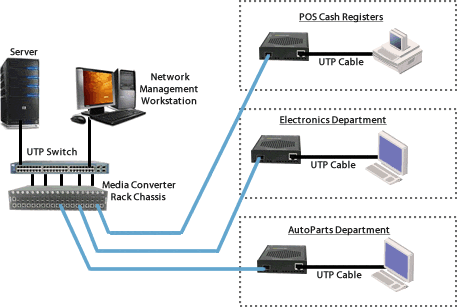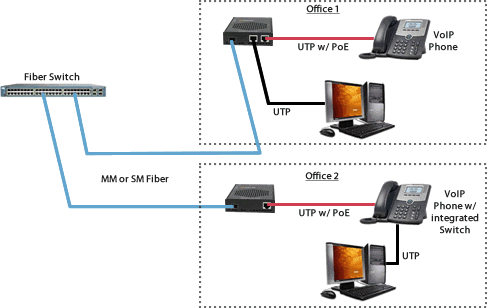Media Converters offer flexible expansion in Horizontal Networks
Media Converters ease the integration of fiber cabling to extend network distances avoid EMI disruptions and tighten data security
Every network has a horizontal portion. It incorporates the point from the wiring closet switch on any given floor in a building to workstations, printers, point-of-sale devices and other hardware. In small networks the entire network would be considered horizontal if it does not require a backbone to aggregate bandwidth.
Though these networks are often simpler than backbone or campus networks, media conversion is required for cost-effective expansion over large distances, avoiding EMI disruptions and security considerations.
In large facilities, such as retail stores and distribution centers, optical cabling is needed to extend the horizontal network to devices beyond the 100 meter distance limitation of copper cabling. Establishing this fiber to Ethernet infrastructure begins with a single server that connects to a copper-based Ethernet switch in the primary computer room. This switch is then connected to a network management controller to oversee all functions. A media converter chassis is also connected to the switch, allowing the Ethernet network to include optical cable where necessary. Each network end point, such as a point-of-sale device, also has a media converter to switch the UTP Ethernet signal to optical signal and send it back to the computer room (Fig1).

An Ethernet to Fiber Media Converter can also be used where there is high level of electromagnetic interference (EMI). This is a common phenomenon found in the horizontal network of industrial plants. This interference can cause corruption of data over copper-based Ethernet links. Data transmitted over fiber optic cable however is completely immune to this type of noise. An Ethernet to Fiber Optic Converter therefore enables companies to inter-connect copper-Ethernet devices over fiber ensuring optimal data transmission across the plant floor. Finally, data security is accelerating Fiber to the Desktop (FTTD) as a common horizontal network example. Data transmitted over fiber is extremely secure since fiber optic cabling does not emit an electronic signal that could be monitored remotely. Additionally, fiber cannot be tapped into without detection. In a FTTD application, Fiber Media Converters with Power over Ethernet (PoE) extend the reach to workstation and VoIP phones. In addition to the fiber to copper conversion, PoE media converters provide standard PoE or PoE+ power to compliant VoIP phones. Fiber is run from an existing data closet to an area with access to power. A PoE Media Converter can be powered by either 48vDC or standard 100 to 240 AC power. The media converter is attached to the power supply and the fiber cable. Copper (UTP or STP cable) Ethernet can be extended another 100 meters to the VoIP phone. The PoE Media Converter is converting the data from fiber to copper, adding power and transmitting it to the VoIP phone (Fig2).

With media conversion systems installed, mixing optical infrastructure with copper cabling can be simple and cost effective. This is a critical concern for many businesses as advanced network systems are becoming critical to keep up with competitors and possibly gain an edge through advanced performance capabilities.